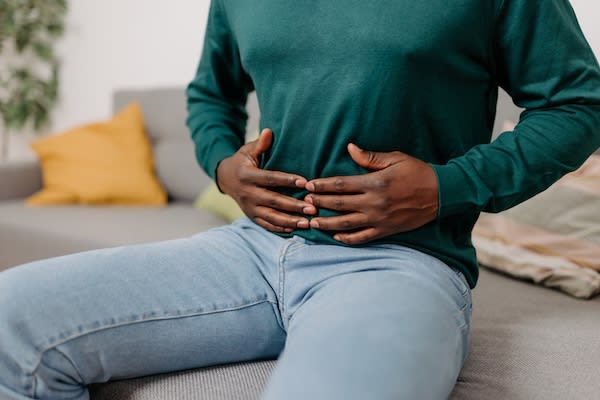Middle stomach pain: Possible causes and when to seek care
[7 MIN READ]
In this article:
-
Middle stomach pain can range from mild digestive issues to more serious conditions. Common causes include gas, indigestion, muscle strain, gastritis, food triggers, pancreatitis, gallbladder problems and peptic ulcers.
-
The central abdomen contains several major organs, including parts of the stomach, intestines and pancreas, making it a complex area where different issues can present similar symptoms.
-
Knowing when to seek medical care is essential. While many causes are minor and treatable at home, persistent, worsening or severe pain — especially with symptoms like fever or vomiting — warrants a visit to the doctor or emergency room.
Middle stomach pain: Possible causes and when to seek care
Stomach pain is frustrating, especially when it shows up in the middle of your abdomen and you’re not sure why. Although it could be something as simple as indigestion, it could signal something more serious, like an ulcer or gallbladder issue. Knowing what’s behind the discomfort can help you feel better faster — and, in some cases, may even prevent a health emergency.
Daniald Rodrigues, M.D., a gastroenterologist at the Providence Center for Digestive Health — Mission Viejo in Mission Viejo, California, breaks down the common causes of mid-abdominal pain, how to tell if it’s something minor or more concerning, and when it’s time to see a doctor.
Common causes of middle stomach pain
The middle part of the abdomen — often called the mid-abdomen or central abdomen — includes several important organs, which is why pain in this area can have many possible causes.
Located between the chest and pelvis, this region houses parts of the stomach, small intestine, pancreas and even portions of the large intestine. That’s why discomfort here may stem from something temporary, like gas, indigestion or constipation, but it could also be linked to a more serious condition, like pancreatitis or an ulcer.
Gas and indigestion
Dr. Rodrigues says gas, indigestion, heartburn and constipation are the most common causes of abdominal pain.
“You have 24 feet of small intestine packed in a small area,” he adds. “It’s common to get some pockets of air and gas building up and causing bloating and discomfort.”
Over-the-counter options like antacids that neutralize stomach acid, or lactose supplements that help your body digest lactose if you’re lactose intolerant, can help prevent or relieve pain caused by common digestion problems. Natural remedies like peppermint and chamomile tea can help, too.
Muscle strain and physical causes
Muscle strain is another common cause of middle stomach pain. A frequent symptom of overuse, a pulled muscle or muscle tear can cause sharp pain that gets worse when you move.
Most of the time, you can treat muscle strains and tears at home with ice, rest and over-the-counter pain medications.
Gastritis and stomach irritation
Infections like H. pylori — a common bacterial infection in the stomach — drinking too much alcohol, the use of certain medications like aspirin and ibuprofen, smoking, and stress can all prompt gastritis, which is inflammation of the stomach lining.
Making lifestyle changes to avoid inflammatory triggers and taking over-the-counter acid reducers like Pepcid® or Prevacid® can often help relieve or prevent gastritis. If your gastritis is due to H. pylori infection, though, you may need antibiotics to kill the bacteria.
Food-related causes
In addition to issues with digestion, middle stomach pain can result from food poisoning, food allergies or food intolerances.
Food poisoning stems from eating something contaminated with a bacteria, virus or other kind of toxin. Symptoms typically include diarrhea and vomiting, as well as an upset stomach. For the most part, getting plenty of rest and drinking lots of water are your best bets if you’re suffering from a bout of food poisoning, but home remedies like taking a spoonful of apple cider vinegar or honey mixed with water from time to time can help, too.
Food allergies occur when something you eat sets off an abnormal immune response. Symptoms can range in severity, but tend to include stomach pain, hives or itching, and swelling of the lips, face or tongue.
If you notice symptoms like this shortly after eating, you should make an appointment with your doctor to rule out a food allergy. Sometimes, the symptoms you’re experiencing may be caused by an ingredient used to prepare the food, and not the food itself. For example, your body may react to an additive used to preserve dried fruit.
When middle stomach pain may be serious
Pain that’s severe, persists or strikes frequently is always cause for concern, Dr. Rodrigues says.
Pancreatitis warning signs
Pancreatitis is a condition that develops when the pancreas — the organ behind the lower part of the stomach that helps the body digest food and regulate blood sugar — gets inflamed. Pancreas inflammation can stem from gallstones blocking the bile duct, kidney stones, too much alcohol use, taking certain medications or a host of other causes.
Sometimes, pancreatitis is acute, meaning it appears suddenly and doesn’t last long. Other times, though, it can be chronic, which means it lasts long-term as damage to the pancreas worsens.
The warning signs of acute pancreatitis include symptoms like pain in the middle of the upper abdomen, fever and vomiting. If you have chronic pancreatitis, the pain may worsen after you eat. You also may notice yourself losing weight without trying.
Always call your doctor if you have stomach pain that worsens over time or doesn’t improve, or if it’s severe. Pancreatitis can cause serious, potentially life-threatening complications, like kidney infection and kidney failure, and pancreatic infection.
Gallbladder problems
Most of the time, gallbladder pain affects the right side of the abdomen — where the organ is located — but you can feel it in the middle of the stomach, too. For example, if you have gallstones, which are hard masses that form from bile, pain tends to start in the middle of the stomach, especially after eating.
Other common causes of gallbladder pain include inflammation (called cholecystitis) and bile duct stones (gallstones that either get stuck in the bile ducts or form there). A doctor can help you determine the cause of your pain and the treatment you need.
Peptic ulcers
Often felt as a burning sensation, peptic ulcers develop as open sores in the lining of the stomach or duodenum, which is the first part of the small intestine. They’re typically caused by factors like H. pylori infection and the regular use of certain pain relievers.
Lifestyle adjustments like reducing alcohol, caffeine and spicy foods from your diet, and taking more care with how often you use medications like aspirin and ibuprofen, can help prevent or relieve peptic ulcer pain.
Heart-related pain
Although it’s uncommon, your middle-of-the-stomach pain may be coming from your heart. This type of pain is known as referred pain and could be linked to a serious problem like a heart attack.
Signs of referred pain include persistent abdominal pain that’s accompanied by other symptoms, like shortness of breath or nausea.
When pain spreads or radiates
Pain in the middle of the stomach also means you should pay attention to whether it remains localized or spreads somewhere else in the body. For example, pain from pancreatitis often begins in the middle of the stomach before radiating to the back. Also, with appendicitis, pain tends to start around the belly button before spreading to the lower right side of the abdomen. Rarely, pain from an ectopic pregnancy, which is a pregnancy outside the uterus, can cause achy, progressive pain, as well.
Still, it’s important to remember that minor issues like gas and indigestion can also cause pain that shifts to different parts of the abdomen.
At-home care for middle stomach pain
Because the majority of middle stomach pain comes from gas and indigestion, you can typically treat it without going to the doctor.
Safe pain relief methods
Making dietary changes is one of your best bets for preventing or relieving pain in the middle of the abdomen. For example, instead of Flamin’ Hot Cheetos for your snack today, try easy-to-digest foods like bananas or crackers.
In addition, if you think your pain stems from gas, an over-the-counter medicine that contains the ingredient simethicone can help relieve it. If you think it’s caused by heartburn, try an acid reducer or antacid. A stool softener or laxative can help with constipation.
You can also try a heating pad or natural remedies like ginger or chamomile tea.
What to avoid
Steer clear of spicy, fatty and fried foods, as well as caffeine, carbonated beverages, sugar and alcohol, which tend to irritate the stomach lining. You should also avoid eating before bed.
Eating too fast and overeating can also cause stomach pain.
When to see a doctor for middle stomach pain
If pain persists, gets worse over time, shows up more frequently or is accompanied by other symptoms, it’s time to call the doctor.
Routine appointment, urgent care or emergency room
Although it’s a bit of a gray area, you can schedule an appointment with your primary care provider or gastroenterologist for certain kinds of middle stomach pain. For instance, if you have recurring pain after eating a certain type of food or pain with indigestion, you can usually wait to get medical attention until you can get in with your doctor.
You can opt for urgent care if the pain isn’t that intense and you’re able to keep down fluids. But pain that’s intense, comes on suddenly or is followed by a symptom like a high fever, vomiting blood or chest pain should immediately result in a trip to the emergency room.
“When in doubt, you should always get it checked out,” Dr. Rodrigues says.
Contributing caregiver

Daniald Rodrigues, M.D., is a gastroenterologist at the Providence Center for Digestive Health — Mission Viejo in Mission Viejo, California.
Find a doctor
If you are looking for a primary care provider or gastroenterologist, you can search for one who’s right for you in our provider directory. You can also find out more about our gastrointestinal services.
Download the Providence app
It’s all in the app: easily stay connected with Providence and your health. With the Providence app, you can schedule appointments, have virtual visits from the comfort of your own home, get health recommendations personalized for you, access your health records and so much more. Learn more and download the app.
Related resources
Understanding your stomach pain: When to worry
Upper abdominal pain: Causes, symptoms and relief
Left-side stomach pain: When it’s time to see a doctor
Right-side stomach pain: Causes and when to see a doctor
This information is not intended as a substitute for professional medical care. Always follow your health care professional’s instructions.
